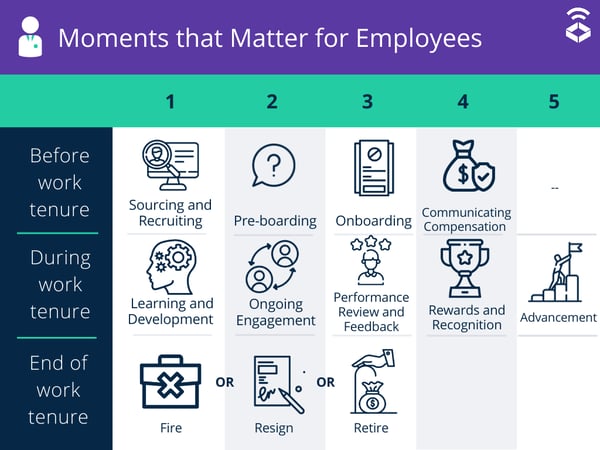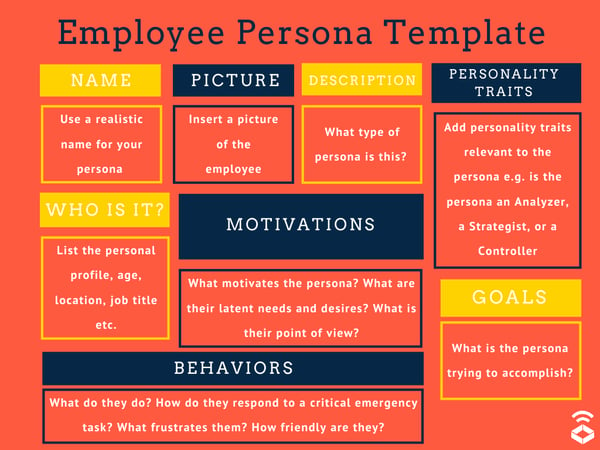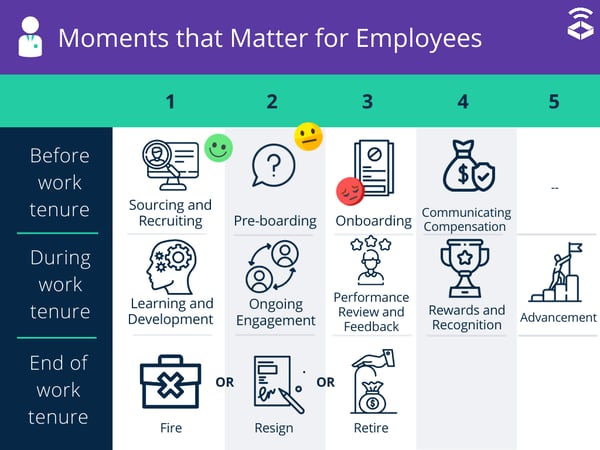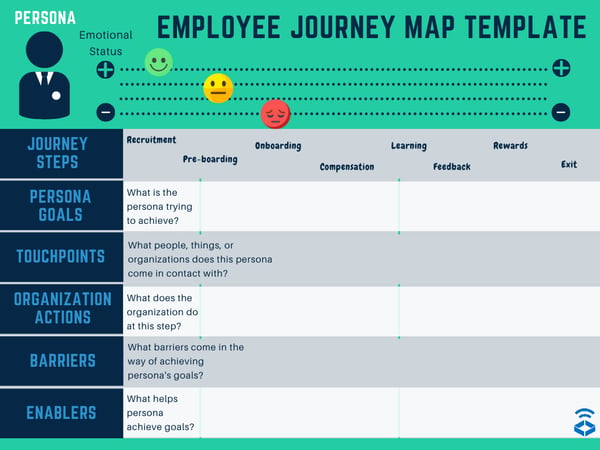September 2, 2025
 by Ramiah Adeen / September 2, 2025
by Ramiah Adeen / September 2, 2025
.png?width=690&height=400&name=G2CM_GI155_Glossary_Article_Images_Employee_Segmentation_no-letter_V1%20(1).png)
First impressions define your reputation as an employer. Candidates decide whether they feel valued before they even apply, and a smooth, respectful process signals that your company cares about its people.
You hire outstanding talent, yet somewhere between onboarding and the first performance review, enthusiasm starts to wane. Engagement dips, retention risks rise, and as part of the HR team, you’re left wondering where the connection broke. But your employees likely sent signals long before they disengaged or resigned.
In today’s era of the Great Resignation and quiet quitting, you need a way to recognize those signals early and act on them. Employee journey mapping makes that possible, giving HR leaders like you a clear view of the employee experience so you can intervene before small issues become big problems.
Employee journey mapping is the process of visualizing each stage of an employee’s experience within a company, from recruitment to exit. It identifies key touchpoints, emotions, and pain points to improve engagement, streamline processes, and align HR strategies with employee needs.
By mapping the employee lifecycle, from the first interview to career development milestones, you gain a clearer picture of what employees need, where frustrations are building, and how to create experiences that keep them motivated to stay.
A range of employee engagement and feedback tools can support this process, from running employee surveys and eNPS programs to gathering real-time insights from employees on their experiences, challenges, and needs that reveal what’s really driving engagement.
This article will break down what employee journey mapping is, why it matters for today’s HR leaders, and how to create your own map with steps, examples, and templates drawn from leading practices.
Whether you’re completely new to journey mapping or refining an existing process, you’ll leave with a clear framework for mapping the employee lifecycle, spotting pain points early, and using data-backed insights to build a workplace where people feel connected, supported, and proud to contribute.
Most companies invest heavily in mapping customer experiences to boost retention, yet many forget their employees deserve the same attention. Mapping the employee journey is just as critical for keeping your best people.
A Gallup study found that 42% of employees who voluntarily left their organization in the past year believe their manager or company could have prevented it. Journey mapping uncovers the “moments that matter” in an employee’s lifecycle so you can act before issues escalate and improve engagement and satisfaction.
Mapping also makes a measurable difference to everyday HR outcomes. It helps you:
When employees feel supported and engaged, they’re more likely to give discretionary effort, going the extra mile because they want to, not because they have to. That boosts output, strengthens culture, and reduces turnover.
Beyond retention, journey mapping helps meet today’s evolving workplace expectations. Looking at data across demographics, locations, and roles reveals inequities in DEI efforts, shows how hybrid and remote policies are affecting employees, and gives you the insight to design more inclusive, seamless experiences for every segment of your workforce.
That’s why more HR teams now treat journey mapping as a core strategy, reporting higher engagement, lower turnover, and faster feedback loops for continuous improvement.
Now that we know how important the employee journey map is, let’s take a look at what it is about.
An employee journey map typically consists of 10 basic stages, or moments that matter:
These moments are illustrated below to give you a fair idea of their chronological order in an employee’s journey.

However, note that the order of moments in the “during work tenure” phase does not have to be fixed for each employee. It can vary for different employees and their personas (which we will discuss later). Let’s go through the employee journey map and discuss each of its stages in detail.
This is often the most important stage of the employee journey because it’s the first touchpoint with your organization. Every interaction here shapes your employer brand and sets expectations for what it’s like to work with you.
First impressions define your reputation as an employer. Candidates decide whether they feel valued before they even apply, and a smooth, respectful process signals that your company cares about its people.
When sourcing and recruiting are done well, you not only fill roles faster but also set the tone for an employee experience built on trust and care.
Pre-boarding is the stage between offer acceptance and a new hire’s first day. It sets the tone for their excitement and helps ease the anxiety of starting a new job.
A thoughtful pre-boarding experience reassures new hires that they’ve made the right choice. By giving them clear, friendly information before day one, you reduce uncertainty, build trust, and increase the chances they arrive engaged and ready to contribute.
Onboarding is where the rubber hits the road. This is where your employees get the actual sense of the nature of work and the work environment. Did you make your new employee sit on a desk that was later occupied by someone else? Did their laptop encounter issues and they weren’t able to start work for two days? Did their team warmly welcome them? These things may seem trivial but it’s the little things that really matter when it comes to how a person feels about working at your company.
A smooth onboarding experience builds confidence, accelerates productivity, and strengthens connections. Delays, confusion, or an impersonal welcome can make new employees question their decision before they’ve even settled in. With remote and hybrid work on the rise, thoughtful onboarding is more critical than ever.
Compensation and benefits are the tangible proof of how much you value your employees. Clear, competitive packages give new hires confidence and help set realistic expectations before they start.
Even the most attractive job title or employer brand can’t outweigh unclear or inconsistent pay and perks. If employees feel misled or unsupported at this stage, trust erodes before day one, making engagement and retention harder down the road.
Great company culture aside, if the work at your organization isn’t challenging enough to foster ongoing learning and development, employees might just start looking for other opportunities on Glassdoor or LinkedIn during the lunch break. Ongoing learning and development keep employees challenged and growing throughout their tenure.
When employees see a clear path to learn new skills and advance, they’re more engaged and less likely to leave. A strong development culture prevents burnout, keeps work fresh, and signals that you’re invested in their future.
Ongoing engagement is about more than just doing the job — it’s about how employees feel day to day at work. The sense of belonging, camaraderie, and connection they experience plays a major role in how long they stay and how well they perform.
Humans have an inherent need for social acceptance. Even a highly skilled employee may leave if they feel isolated or unacknowledged. Building an environment where people feel included, valued, and part of the team strengthens culture and retention.
Performance planning, feedback, and review give employees clarity on what’s expected and how they’re doing. Without clear goals and constructive feedback, even strong performers can become frustrated, distracted, or disengaged.
When expectations are realistic and feedback is regular, employees know what success looks like and feel supported in reaching it. This builds motivation and trust, whereas unclear goals or unfair reviews can quickly erode morale.
Rewards and recognition show employees that their contributions matter every day, not just at major milestones. Consistent acknowledgement keeps motivation high and strengthens loyalty.
Even the most dedicated employees will feel undervalued if their hard work goes unnoticed. Recognition, whether verbal or monetary, signals that their efforts have an impact and are appreciated by leaders at every level, not just their immediate team
Advancement or promotion in a career is another crucial moment in the journey of an employee. It assures them that they’re progressing in their profession and have gained enough skills and experience over the years to reach this position.
As an HR professional, you must also ensure that the concerned employees receive adequate onboarding when they’re promoted to a new job title. Intra-team and inter-team syncs are important to make sure that the promoted employee is aware of the overarching company goals and can develop team goals based on that. It is also vital to discuss how the daily routine of the employee is to change after the promotion.
Career progression boosts motivation, engagement, and retention. Without clear paths for growth, employees may look elsewhere to advance. Handling promotions thoughtfully also helps newly elevated employees succeed in their new roles.
This stage marks the end of an employee’s journey with your organization, but the experience you create here leaves a lasting impression. Former employees can still influence your reputation through referrals, reviews, and how they speak about your company.
A thoughtful offboarding process preserves relationships, protects institutional knowledge, and shows remaining employees that people are treated with respect, even when they leave. Cold or perfunctory exits burn bridges and can harm your employer brand.
Now that we know the steps in an employee journey map, let’s learn how to make one. There are four basic steps to creating an employee journey map.
Before you begin mapping, anchor the work with a clear purpose. HR teams that skip this step often end up with a “pretty” map that doesn’t change anything. Being explicit about why you’re mapping and what you hope to improve ensures the project has focus and measurable impact, whether that’s reducing first-year attrition, improving onboarding satisfaction, or strengthening leadership pipelines.
Each employee’s journey is different. It is based on their qualifications, skill set, personality traits, compensation level, and their internal needs and drivers. For this reason, it is important to segment your employees into different personas and develop employee journey maps suited to each persona. It’s all about getting inside your employees’ heads and discovering what motivates them and what holds them back.

Personas are only as good as the data behind them. This step grounds your map in real feedback rather than assumptions. By collecting honest input about each stage of the employee lifecycle and the emotions tied to it, you can pinpoint where the experience is breaking down and what’s working well.

When making an employee journey map, you can also include other aspects that impact an employee’s journey, such as their goals, touchpoints, barriers, and motivators. Below is an employee journey map template for your reference:

Not every stage carries the same weight for every employee. Some will forgive a clunky onboarding if they see a path to advancement; others will walk after one bad manager interaction. Pinpointing the “moments that matter” helps HR focus limited resources on the experiences with the biggest impact on engagement and retention.
Journey mapping only creates value if it leads to action. Turning your findings into tangible changes and tracking whether they work builds credibility for HR and momentum for continuous improvement. This step is where you shift from insight to impact.
An employee journey map isn’t a one-off deliverable. Your workforce, policies, and market conditions evolve and so do employee expectations. Keeping the map visible, celebrating quick wins, and refreshing it regularly ensures it remains a living tool rather than a forgotten file.
Once you’ve mapped out each stage of the employee journey and identified the moments that matter, the next step is putting those insights into action. That’s where the right tools come in. From employee engagement platforms and feedback software to HR analytics dashboards, technology can help you collect data more efficiently, visualize journeys, and track the impact of your improvements over time. The right tools make collecting data, segmenting personas, and tracking improvements much easier.
Even with a solid process and the right tools, employee journey mapping can hit roadblocks. Anticipating them and having a plan makes the difference between a one-off exercise and a sustained improvement effort.
Journey mapping requires time, resources, and sustained attention. Without executive support, it can fizzle out. Involve leaders from the start by linking mapping goals to business priorities, such as lowering turnover costs, reducing time to productivity, or improving employer brand rankings. Give them a preview of the data you will capture and share quick wins early, like reducing new-hire dropout rates, to build credibility.
Employee feedback is often scattered across exit interviews, pulse surveys, HRIS records, and spreadsheets, making it hard to build a unified view. Create a central repository or dashboard for all employee experience data. Standardise how feedback is collected across departments so the results are comparable. A simple taxonomy of stages, touchpoints, and emotions will help you merge data from multiple sources.
Employees are less likely to respond to long or irrelevant surveys, or when they fear reprisal. Keep requests short, targeted to the stage you are examining, and explain why you are asking. Offer anonymity where possible. Close the loop by communicating what you heard and what you are changing as a result. Participation usually increases once people see that their feedback leads to action.
Many organisations produce a beautiful map and stop there. Before you launch, decide who will own each stage of the map. Create a small cross-functional team to prioritise pain points and assign timelines and budgets for fixes. Add journey-map actions to managers’ objectives so improvements are tracked just like any other KPI.
Workforces and policies evolve quickly. A static map becomes obsolete within months. Build refresh cycles into your HR calendar (for example, updating personas and metrics every 12 months). Use HR dashboards to monitor leading indicators such as turnover spikes or low eNPS in a department. These triggers tell you when to revisit the map, even between scheduled refreshes.
Treat journey mapping like a mutual commitment: you invest in employees as much as they invest in you by choosing to work here. Use that principle to guide how you roll this out across the company.
If you use these practices as guardrails, your journey map becomes more than a diagram. It turns into an operating system for how your company attracts, onboards, grows and keeps great people.
Employee journey mapping isn’t just a buzzword. For me, it’s been a complete shift in how I think about HR. In the same way marketing teams obsess over customer touchpoints, you can design employee experiences with the same rigor and empathy.
Think about the tiny cues that shape how you feel as a customer: a handwritten thank-you card, a seamless return, a friendly text reminder. Those same micro-moments exist inside your organization, too. When you make sure a laptop is waiting on day one, send a quick voice note before someone’s big presentation, or map out a clear path to their next role, you’re creating small human signals that change how they feel about working for you.
When you treat the employee journey as a living, evolving map rather than a static chart, you stop reacting to disengagement and start engineering trust, belonging, and pride. That’s the unique power of journey mapping: it gives you a real-time dashboard of what matters so you can make small, human changes that lead to big, lasting impact.
A healthy employee journey also depends on a healthy workforce. If you’re ready to support your people beyond processes and policies, explore corporate wellness software on G2 as part of your toolkit.
This article was originally published in 2020. It has been updated with new information.
Ramiah Adeen is a technical writer and content marketer at AssetSonar, an IT asset management software for startups, SMBs, and many IT-intensive enterprises. She’s a guest blogger who is passionate about emerging trends in the sphere of digital marketing. She’s also a Potterhead, a chai enthusiast, and likes playing indie songs on her ukulele.
Although many people understand that employee engagement is important for a thriving company...
 by Courtney Moran
by Courtney Moran
Employee onboarding looks different depending on what stage of the employee experience you’re...
 by Lauren Pope
by Lauren Pope
First impressions are everything — and the workplace is no exception.
 by Cameron Nouri
by Cameron Nouri
Although many people understand that employee engagement is important for a thriving company...
 by Courtney Moran
by Courtney Moran
Employee onboarding looks different depending on what stage of the employee experience you’re...
 by Lauren Pope
by Lauren Pope


